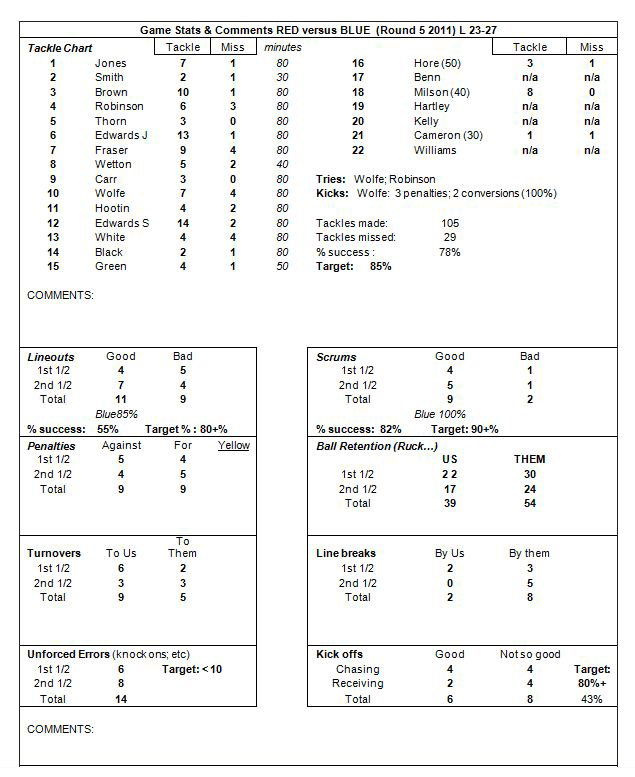- Rugby Toolbox
- Resources & Education
- Learn more
- Articles
- Snook on Coaching
- Key Performance Indicators
- Ruck & Run Drill
- Playing Philosophy – Ruck & Run Coaching Components
- Playing Philosophy – Spread the Forwards
- Playing Philosophy – A forward behind the ruck
- Playing Philosophy – Ruck & Run
- Playing Philosophy – An idea!
- The Breakdown
- Building Positivity [3]
- Building Positivity [2]
- Building Positivity
- Fitness and Game Related Activities
- Getting the Head Working
- Missiles are Dangerous
- Use of Video
- Winger Attacking Outside First-Five
- Player Profiling
- Selection
- Fitness Away from the Team Session
- Playing Philosophy (Pre season Prep)
- Coaching the Coaches
- The Rugby Coordinator and Pre-Season Preparation
- Why Not Use Tap Penalties More Often?
- Why Kick the Ball Down the Middle of the Field?
- Defending the 5 Metre Lineout Drive
- Scoring from the 5 Metre Lineout
- What are the Kicking Team Aiming to Achieve from Halfway Restart
- Should We Practice Scoring Tries?
- Team Culture
- Looking After Your Players
- Coach Survival Tips
- Under 11/13 – Backline Defence
- Under 11/13 – Ruck Defence
- Under 11/13 – Back Attack
- Under 13 – The Counter Attack
- Under 11/13 – The Maul
- Under 11/13 – Lineouts
- Under 11/13 – Decision Making
- Under 11/13 – Support Play
- Under 11/13 – Dive Pass and More
- Under 11/13 – Drop & Grubber Kick /Highball Catch
- Under 11/13 – Front on Tackling
- Under 11/13 – Contact – Getting Up – The Ruck
- Under 11/13 – The Coaching Session
- Under 8/10 – Using Space
- Under 8/10 – Kicking
- Under 8/10 – Contact and Picking Up the Ball
- U8/U10 Draw & Pass and Sidestep
- Under 8/10 – The Tackle
- Under 8/10 – The Coaching Session
- Under 7 – Test Your Coaching – Support Play
- Tap Pass and Swerve U7
- Ball Familiarisation; Passing & Receiving
- Activities for the Non-Contact Tackle
- Under 7 – The Coaching Session
- Coaching Teenagers – After the Ruck
- Coaching Teenagers – The Practice Session
- Coaching Teenagers – Best Practice
- Coaching Kids – Best Practice
- Plays from a Tap Penalty
- Running Plays from a 5 Man Lineout
- Driving Plays from a 5 Man Lineout
- Strike Plays at the End of the Lineout
- Back Strike Plays at the Lineout
- Wide Strike at the Scrum (2)
- Wide Strike at the Scrum
- Midfield Attack at the Scrum
- No 8 Plays at the Scrum (2)
- No 8 Plays at the Scrum
- The Cut Out Pass
- Skills to Penetrate (2)
- Skills to Penetrate
- Movements to Penetrate
- Patterns to Penetrate
- Contact and Continuity
- Keeping the Ball Alive Out Wide
- Pre Season Support Activities
- Checklist
- Understanding the game
- The Playing Philosophy
- The Lineout
- Overview
- Team Profile
- Start Now!
- Backrow
- Nine and Ten
- Rugby-related Fitness Activities
- The Psychological Edge
- Open Field Play
- Key Performance Indicators
- Improving Team Performance
- Backline Attack Concepts
- Tactics at Phase Play
- Playing Philosophy
- The ‘Stop Focus’
- Kick Attack
- Clearing the 22
- Wide Attack at Phase
- Player Focus
- Scrum Preparation
- Lineout Preparation
- Back Attack Preparation
- Sevens Preparation
- Sevens Kick Offs
- Sevens Scrum and Lineout
- Sevens Attack Patterns
- Sevens Defence
- 7's Selection and Game Planning
- Coaching and Leadership
- How the Game Evolves
- Changing Within the Game
- Learning from the Television.
- Using Tap Penalties Wisely
- Defence Drills
- Defence Drills for Tight Five
- Team Defence and TUB’ing
- Establishing Patterns from the Ruck
- Structured Phase Play
- Structuring Phase Play on the Run
- Coaching Roles
- Structuring a Close in Tackling/Defensive Session
- Coaching in Threes
- Attacking Back Play
- Kick Off Chase
- Wrap Around Back Plays
- Lineout Plans
- Looking and Learning
- Motivating Your Players
- Scrum Attack
- Refocusing the Team
- Monitoring the Progress
- Learning the Game
- Playing to the Laws
- Small is OK
- Decisions After the Tackle
- Improving Your Coaching
- Food for Thought
- More Food for Thought
- Passing & Catching
- How Ireland Nearly Beat the All Blacks
- The Progressive Coach
- Try Something New
- Encouraging Excitement
- The Mental Approach
- Where to Start
- Being the Best You Can Be
- Off the Ball Decisions
- Lineouts Difficult to Master
- Decisions on the Run
- Rucking and Rolling
- A Successful Approach
- Gaining Clarity
- Manipulation vs Physicality
- Beating the Drift
- To Ruck or Not to Ruck
- Stopping the Lineout Drive
- Fine Tuning the Planning
- It's a Running Game
- RugbySmart 2015
- Using the Shoulders
- Loosehead Prop / Tighthead Prop
- Position Specific – Hooker
- Position Specific – Lock
- Position Specific – Blindside Flanker
- Position Specific – Openside Flanker
- Position Specific – No 8
- Position Specific – Halfback
- Position Specific – First Five Eighth
- Position Specific – Second Five Eighth
- Position Specific – Centre Three-quarter
- Position Specific – Wing
- Position Specific – Fullback
Key Performance Indicators

PLANNING & IMPLEMENTING: 2- Key Performance Indicators - Ian Snook
There are an unlimited number of Key Performance Indicators (KPI’s) that can be used. The coach must decide which ones best suit his purposes given the game plan and his knowledge of his own players and the opposition.
The advantages of introducing KPI’s for the team is to draw attention to important aspects of the game plan and if so set up, to monitor individual performances of the players. The players really enjoy receiving this information and it provides them with a focus and a motivation to get better.
Essentially the KPI’s selected should provide information about:
- Possession: sources; quantity; quality
- Ball Retention: outcomes of play; speed of recycling; time in possession; turnovers.
- Progress with ball: against gain line; how achieved; where achieved; opportunities created and outcomes.
- Territory: time in opposition half particularly in the ‘red zone’.
- Defence: tackles made; tackles missed; grade of tackles; opposition line breaks.
The KPI’s are an attempt to establish a cause/effect relationship for key outcomes in a match. They draw attention to parts of the tactical or technical framework that may require change.
The following are some events which influence matches and which you may wish to use in your KPI’s:
- Positives
- Turnover to us
- Grade 3 tackle.
- Lineout win: your ball / their ball
- A big scrum
- Ball recovery on your own kick off
- A Line break
- Your ball scrum or lineout hard on attack
- Negatives
- Ball turned over by us
- Missed tackle
- Missed touch with a clearing kick
- Penalty conceded when in possession
- Lineout loss on our ball
- Poor scrum
- Ball loss when receiving a restart
- Early try conceded
- Player sent off or sin binned
- Loss of lineout or scrum hard on attack
In addition to match day KPI’s which are evaluated at the conclusion of any game; it is a good idea to monitor players and KPI’s during a match. These will provide the coach with relevant discussion points at half time and ensure the second half is planned with thought and detail.
If for example you are concerned about the lack of accuracy in the ‘tackle/ruck’ zone you might have a sheet similar to this to clarify your thoughts for half time.
- Turnovers after contact: close / wide:
- Quality of ball: quick / slow / re-set:
- Body positions: high / low:
- Gain line achieved: close / wide:
- Tackles: missed / secure / big hits:
- Specific players to talk to: what / how to fix / good stuff.
If the team can get a person to video the game then this will open up a whole new world of being able to be far more specific in what is needed for your team as far as the coaches’ input is concerned. The following sheet is an example of what can be produced for the team whilst watching the game video each week. Try it out. The players will appreciate it.
